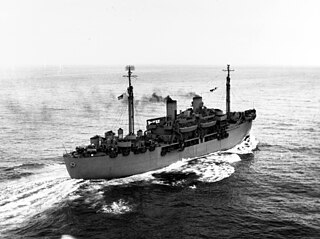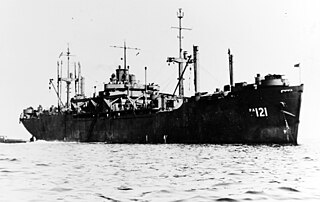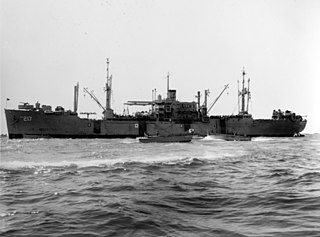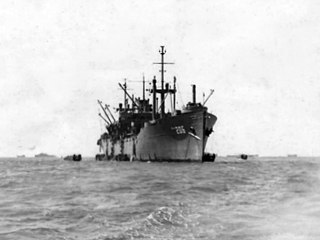Training vessel
Following commissioning, Sherburne proceeded to the Naval Supply Depot at Oakland, California. She remained in the San Francisco area until getting under way for San Pedro, California for shakedown training which she completed on 20 October. The ship then returned to San Francisco to become a training vessel for APA and AP crews being assembled at the Precommissioning Training Center at Treasure Island. During her duty as a training vessel, 24 October to 22 December, she embarked the officers and men of 19 ships for periods of one to five days each for short cruises to the operating areas off Point Reyes. They were given training in ship handling, emergency drills, and in surface and anti-aircraft firing.
Upon completion of brief repairs at the Bethlehem Steel Co. in San Francisco, she got underway on 12 January 1945 toward San Diego for amphibious training. From 14 to 29 January, the ship underwent strenuous training in all phases of amphibious operations; and, on completion of this duty, she returned to the San Francisco area to load cargo.
Pacific service
On 15 February, Sherburne departed San Francisco for Hawaii and arrived at Pearl Harbor on the morning of 21 February. On 20 March, the ship embarked her first contingent of troops and got underway with a convoy bound for the Marshall Islands. She arrived at Eniwetok on 28 March; and, after discharging cargo, proceeded to Kwajalein, arriving there on 31 March; and then to Ulithi which she reached on 6 April. She discharged cargo and troops at both ports. At Ulithi, she embarked a group of marines; and, on 15 April, the ship headed for Guam, arriving at Apra Harbor the following day. After embarking another group of Marines on 20 April, the ship continued on to Saipan, arriving the next day. On 23 April, she embarked a group of Army troops; and, four days later, the ship sailed in convoy for Okinawa.
Sherburne arrived off Okinawa late in the afternoon of 1 May, and immediately began debarking troops and cargo. Operations were delayed by bad weather and air attacks; but, on the morning of 4 May, the ship completed offloading and got underway to return to Ulithi, arriving at that base on 9 May. Sailing the next day, she moored at San Francisco on 24 May. There she embarked troops; and, on 2 June, again sailed for the forward area, this time to the Philippines. She refueled at Eniwetok and Ulithi, and arrived at Manila on the morning of 23 May. On 4 July, she loaded Army troops for Cebu and delivered them there two days later. She then proceeded via Leyte to Biak, where she arrived on 11 July. There she loaded Army troops and sailed for Zamboanga, where she disembarked some of her troops on 17 July. Arriving at Manila two days later, she put the rest of her troops and cargo ashore and shifted to Subic Bay on 25 July for minor repairs and upkeep.
On 4 August 1945, Sherburne sailed for Lucena in Tayabas Bay, Luzon, for amphibious training of Army troops. This duty was abruptly terminated at mid-month by the Empire of Japanese capitulation. The ship immediately returned via Manila to Batangas Bay to load troops of the 1st Cavalry Division and the 11th Airborne Division for the occupation of the Tokyo region. Loading was completed on 24 August; and, on the following day, the ship was underway in convoy for Yokohama, Japan. The convoy entered Tokyo Bay early on the morning of 2 September, and proceeded up the bay. Sherburne passed Missouri at approximately the time of the reading of the surrender document on board that battleship. As the transport dropped anchor off the Yokohama breakwater, her radio receiver was announcing the final signature of the document. Debarkation of troops was completed in the afternoon; and, on the following day, the ship moored alongside a Yokohama pier to discharge cargo. Unloading was completed that evening; and, on 4 September, the ship was under way to return to Zamboanga for another contingent of occupation troops.
On 11 September, Sherburne put into Leyte for fuel and supplies; then continued to Zamboanga, arriving on 16 September. Loading of troops and cargo of the 41st Infantry Division was completed on 19 September. After picking up more troops and boats at Bugo, Mindanao, the ship sailed from Abuyog, Leyte, on 22 September for Kure, Japan. On 23 September, the convoy was diverted to Okinawa because of a delay in preparations at its destination; and the ship anchored in Buckner Bay, Okinawa, the same day. She was forced to sea from 28 September to 1 October to evade Tropical Storm Kate; and, on 2 October, got underway for Japan. The ship entered Bungo Suido early on 5 October; and, after cautiously passing through a succession of mined areas in the Inland Sea, reached Hiro Wan the next day. Debarkation of troops and cargo began immediately and was completed on 8 October.
Operation Magic Carpet
Sherburne was next scheduled for duty in "Operation Magic Carpet" to return servicemen to the United States; but she was diverted to Okinawa where, from 12 October to 14 November, she served as accommodation ship for a total of over 1,400 survivors of mine vessels and other craft wrecked there in a recent typhoon. On 28 November, the transport arrived at Seattle, Washington, with a group of homeward-bound servicemen from Okinawa. After a month of repairs, she sailed on 28 December, for Okinawa where, after embarking more troops between 15 and 21 January, she delivered them at San Francisco on 5 February.





















